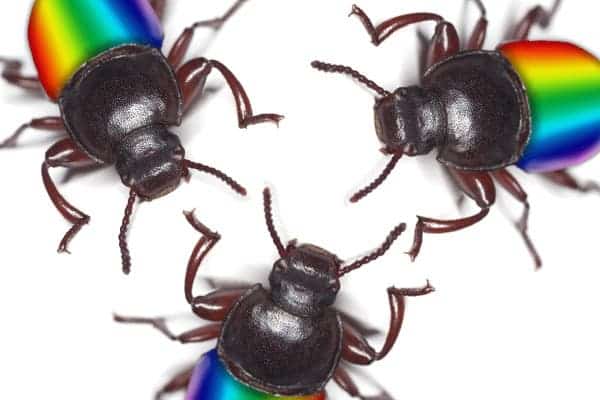Some of you might find it surprising to hear that a lot of animals engage in homosexual behavior. Close to 1,500 species, ranging from primates to gut worms, have been observed engaging in such behavior and this is well documented for 500 of them. No one comes close to insects and spiders, though, which have a significantly larger homosexual/hetero ratio out of all animals. Biologists and animal behaviorists have attempted to explain this proposing various theories, but lack of evidence has failed to substantiate any of these. A recent study found insect homosexuality, though still the result of an adaptive trait, can be explained and supported though a very simple explanation: it’s just a case of mistaken identity.
Deep in the Amazon jungle, a tarantula gently oversees from the comfort and safety of a Brazilian nut tree. When suddenly…
“Hey! Do you mind?”
“What? You’re not into me?”
“I’m a DUDE, man!”
“Sorry, sorry… I thought you were a female, bro. Ishhh…. you know these things happen often”
Now, some of you might find this kind of explanation unrealistic, but it does make sense after you read on. In birds and mammals, homosexual behavior (sexual activity, courtship, affection, pair bonding, and parenting among same-sex animal pairs) has been shown to have evolutionary benefits. It provides “practice” for young adults, means of disposing of old sperm, discourages predators, distracts competitors. and maintains alliances within groups. Biologists have tried to explain homosexual behavior in insects and spiders arguing the same benefits seen in other animals engaging in homosexual behavior applies to them as well.
[RELATED] The weird world of animal sex
After studying 110 species of spiders and insects, Dr. Inon Scharf of Tel Aviv University’s Department of Zoology and Dr. Oliver Martin of ETH Zurich have found that homosexual behavior in bugs is probably accidental in most cases, though.
When studying behaviorism it’s important to put costs and benefits into balance to filter out unfounded hypotheses. In general there is no clear benefit to homosexual behavior in insects, however its cost is just as large as heterosexual behavior – expending sperm, wasting time that could go toward other activities, and boosting the risk of injury, disease, and predation. Heterosexuality has one definite benefit and advantage over homosexuality, though – procreation. Despite this, in some species, up to 85 percent of males engage in homosexual behavior.
There are no clear benefits to homosexuality and the costs are just as high as heterosexuality. The only viable explanation, considering the high count, is that insects and spiders mistake males for females when mating. Why? In some cases, males carry around the scents of females they have just mated with, sending confusing signals to other males. In other cases, males and females look so similar to one another that males cannot tell if potential mates are female until after they have mounted them. And there are other things as well, but really why is it so hard for insects to discriminate genders? Again, it all comes to cost.
Waiting for too long to discriminate if the potential mate in front of you is male or female may translate into a lost opportunity. In other words, the risk of mating with a peer of the same sex is canceled by the more undesirable risk of missing a procreating mate. This explanation is supported by the fact that many species that exhibit homosexual behavior also mate with related species or inanimate objects, like beer bottles—indicating a general tendency toward misidentification. And this might not be all there is to insect and spider homosexuality.
“Homosexual behavior may be genomically linked to being more active, a better forager, or a better competitor,” says Dr. Schart. “So even though misidentifying mates isn’t a desirable trait, it’s part of a package of traits that leaves the insect better adapted overall.”
The findings were reported in the journal Behavioral Ecology and Sociobiology.



